CHCDIV002: Cultural Safety Report on Indigenous Healthcare
VerifiedAdded on 2022/11/29
|11
|2255
|246
Report
AI Summary
This report addresses cultural safety within a nursing context, focusing on a clinical scenario involving an Indigenous child, Ruby, diagnosed with Rheumatic Heart Disease (RHD). It defines RHD, explores its causes, and identifies social determinants of health that make Indigenous populations more susceptible, such as poverty and overcrowding. The report examines treatment needs, compares RHD occurrences between Indigenous and mainstream populations, and defines key terms like cultural awareness and sensitivity. It analyzes the objectives of The Aboriginal and Torres Strait Islander Act 2005, and discusses how factors like discrimination and loss of land impact the health of Aboriginal and Torres Strait Islander people. Furthermore, it suggests strategies for involving Indigenous communities in service planning, improving communication, and ensuring culturally safe care, including effective communication techniques and the impact of past and present trauma. The report also explores indicators of culturally unsafe services and provides insights into how cultural safety is integrated into nursing practice.
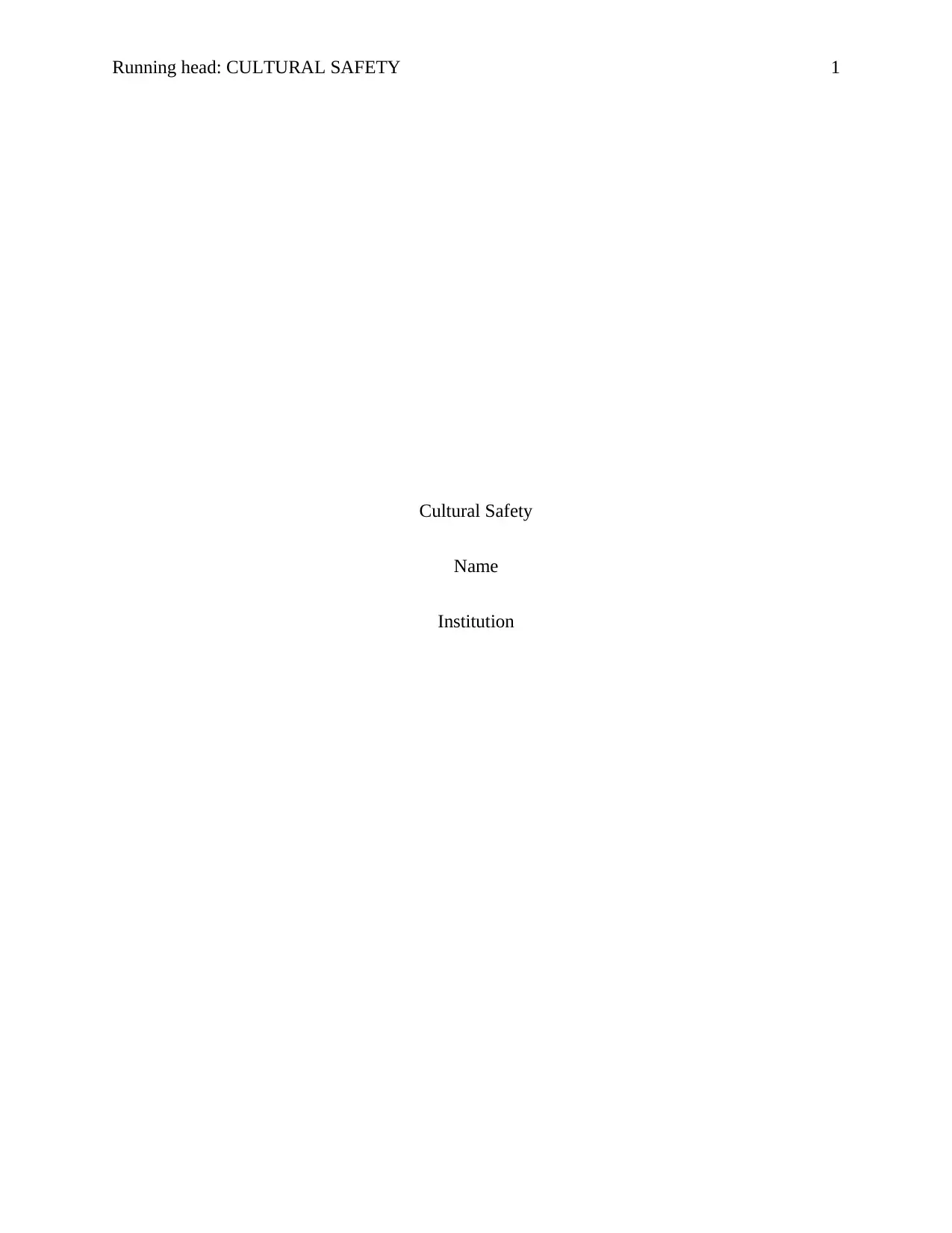
Running head: CULTURAL SAFETY 1
Cultural Safety
Name
Institution
Cultural Safety
Name
Institution
Paraphrase This Document
Need a fresh take? Get an instant paraphrase of this document with our AI Paraphraser
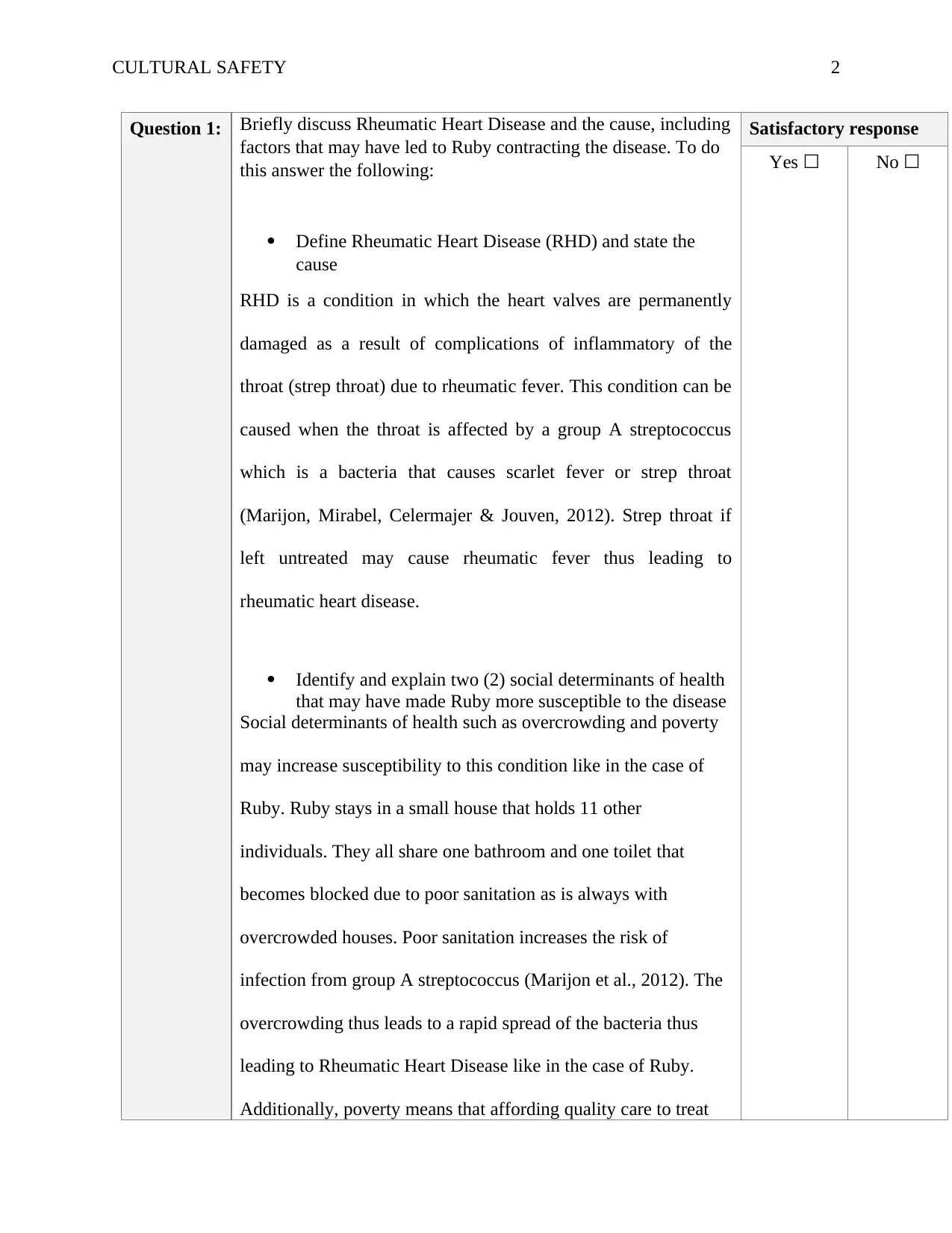
CULTURAL SAFETY 2
Question 1: Briefly discuss Rheumatic Heart Disease and the cause, including
factors that may have led to Ruby contracting the disease. To do
this answer the following:
Define Rheumatic Heart Disease (RHD) and state the
cause
RHD is a condition in which the heart valves are permanently
damaged as a result of complications of inflammatory of the
throat (strep throat) due to rheumatic fever. This condition can be
caused when the throat is affected by a group A streptococcus
which is a bacteria that causes scarlet fever or strep throat
(Marijon, Mirabel, Celermajer & Jouven, 2012). Strep throat if
left untreated may cause rheumatic fever thus leading to
rheumatic heart disease.
Identify and explain two (2) social determinants of health
that may have made Ruby more susceptible to the disease
Social determinants of health such as overcrowding and poverty
may increase susceptibility to this condition like in the case of
Ruby. Ruby stays in a small house that holds 11 other
individuals. They all share one bathroom and one toilet that
becomes blocked due to poor sanitation as is always with
overcrowded houses. Poor sanitation increases the risk of
infection from group A streptococcus (Marijon et al., 2012). The
overcrowding thus leads to a rapid spread of the bacteria thus
leading to Rheumatic Heart Disease like in the case of Ruby.
Additionally, poverty means that affording quality care to treat
Satisfactory response
Yes ☐ No ☐
Question 1: Briefly discuss Rheumatic Heart Disease and the cause, including
factors that may have led to Ruby contracting the disease. To do
this answer the following:
Define Rheumatic Heart Disease (RHD) and state the
cause
RHD is a condition in which the heart valves are permanently
damaged as a result of complications of inflammatory of the
throat (strep throat) due to rheumatic fever. This condition can be
caused when the throat is affected by a group A streptococcus
which is a bacteria that causes scarlet fever or strep throat
(Marijon, Mirabel, Celermajer & Jouven, 2012). Strep throat if
left untreated may cause rheumatic fever thus leading to
rheumatic heart disease.
Identify and explain two (2) social determinants of health
that may have made Ruby more susceptible to the disease
Social determinants of health such as overcrowding and poverty
may increase susceptibility to this condition like in the case of
Ruby. Ruby stays in a small house that holds 11 other
individuals. They all share one bathroom and one toilet that
becomes blocked due to poor sanitation as is always with
overcrowded houses. Poor sanitation increases the risk of
infection from group A streptococcus (Marijon et al., 2012). The
overcrowding thus leads to a rapid spread of the bacteria thus
leading to Rheumatic Heart Disease like in the case of Ruby.
Additionally, poverty means that affording quality care to treat
Satisfactory response
Yes ☐ No ☐
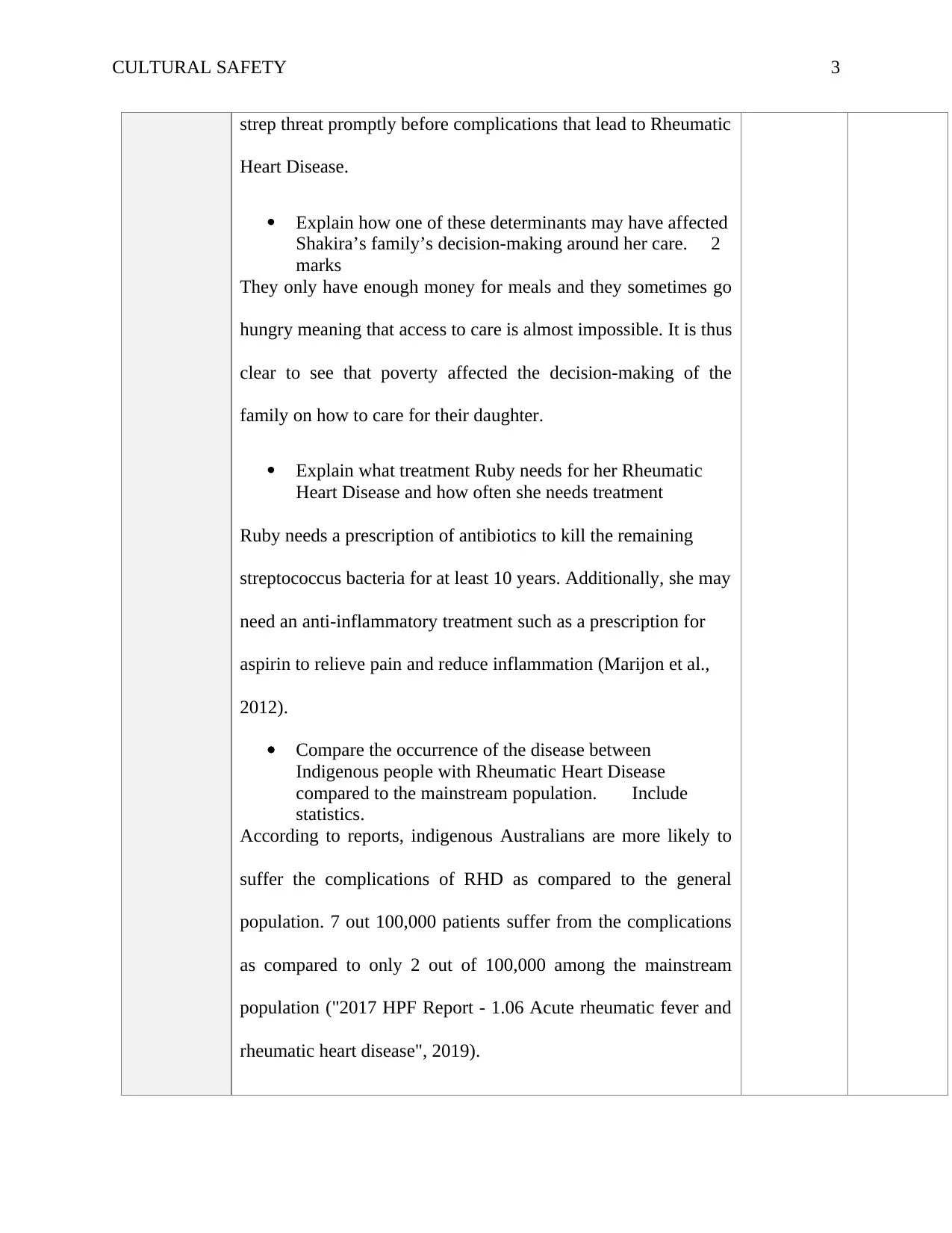
CULTURAL SAFETY 3
strep threat promptly before complications that lead to Rheumatic
Heart Disease.
Explain how one of these determinants may have affected
Shakira’s family’s decision-making around her care. 2
marks
They only have enough money for meals and they sometimes go
hungry meaning that access to care is almost impossible. It is thus
clear to see that poverty affected the decision-making of the
family on how to care for their daughter.
Explain what treatment Ruby needs for her Rheumatic
Heart Disease and how often she needs treatment
Ruby needs a prescription of antibiotics to kill the remaining
streptococcus bacteria for at least 10 years. Additionally, she may
need an anti-inflammatory treatment such as a prescription for
aspirin to relieve pain and reduce inflammation (Marijon et al.,
2012).
Compare the occurrence of the disease between
Indigenous people with Rheumatic Heart Disease
compared to the mainstream population. Include
statistics.
According to reports, indigenous Australians are more likely to
suffer the complications of RHD as compared to the general
population. 7 out 100,000 patients suffer from the complications
as compared to only 2 out of 100,000 among the mainstream
population ("2017 HPF Report - 1.06 Acute rheumatic fever and
rheumatic heart disease", 2019).
strep threat promptly before complications that lead to Rheumatic
Heart Disease.
Explain how one of these determinants may have affected
Shakira’s family’s decision-making around her care. 2
marks
They only have enough money for meals and they sometimes go
hungry meaning that access to care is almost impossible. It is thus
clear to see that poverty affected the decision-making of the
family on how to care for their daughter.
Explain what treatment Ruby needs for her Rheumatic
Heart Disease and how often she needs treatment
Ruby needs a prescription of antibiotics to kill the remaining
streptococcus bacteria for at least 10 years. Additionally, she may
need an anti-inflammatory treatment such as a prescription for
aspirin to relieve pain and reduce inflammation (Marijon et al.,
2012).
Compare the occurrence of the disease between
Indigenous people with Rheumatic Heart Disease
compared to the mainstream population. Include
statistics.
According to reports, indigenous Australians are more likely to
suffer the complications of RHD as compared to the general
population. 7 out 100,000 patients suffer from the complications
as compared to only 2 out of 100,000 among the mainstream
population ("2017 HPF Report - 1.06 Acute rheumatic fever and
rheumatic heart disease", 2019).
⊘ This is a preview!⊘
Do you want full access?
Subscribe today to unlock all pages.

Trusted by 1+ million students worldwide
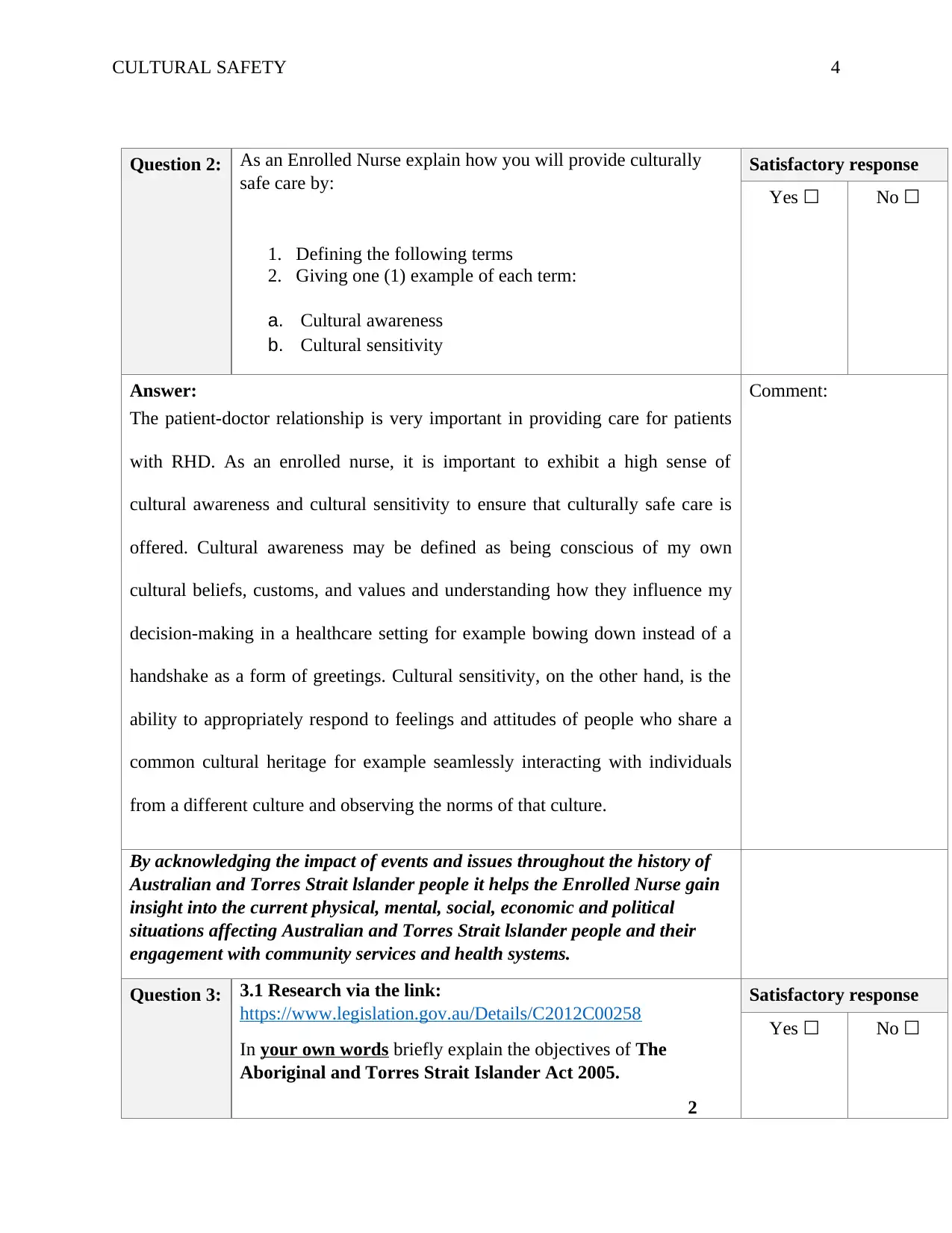
CULTURAL SAFETY 4
Question 2: As an Enrolled Nurse explain how you will provide culturally
safe care by:
1. Defining the following terms
2. Giving one (1) example of each term:
a. Cultural awareness
b. Cultural sensitivity
Satisfactory response
Yes ☐ No ☐
Answer:
The patient-doctor relationship is very important in providing care for patients
with RHD. As an enrolled nurse, it is important to exhibit a high sense of
cultural awareness and cultural sensitivity to ensure that culturally safe care is
offered. Cultural awareness may be defined as being conscious of my own
cultural beliefs, customs, and values and understanding how they influence my
decision-making in a healthcare setting for example bowing down instead of a
handshake as a form of greetings. Cultural sensitivity, on the other hand, is the
ability to appropriately respond to feelings and attitudes of people who share a
common cultural heritage for example seamlessly interacting with individuals
from a different culture and observing the norms of that culture.
Comment:
By acknowledging the impact of events and issues throughout the history of
Australian and Torres Strait lslander people it helps the Enrolled Nurse gain
insight into the current physical, mental, social, economic and political
situations affecting Australian and Torres Strait lslander people and their
engagement with community services and health systems.
Question 3: 3.1 Research via the link:
https://www.legislation.gov.au/Details/C2012C00258
In your own words briefly explain the objectives of The
Aboriginal and Torres Strait Islander Act 2005.
2
Satisfactory response
Yes ☐ No ☐
Question 2: As an Enrolled Nurse explain how you will provide culturally
safe care by:
1. Defining the following terms
2. Giving one (1) example of each term:
a. Cultural awareness
b. Cultural sensitivity
Satisfactory response
Yes ☐ No ☐
Answer:
The patient-doctor relationship is very important in providing care for patients
with RHD. As an enrolled nurse, it is important to exhibit a high sense of
cultural awareness and cultural sensitivity to ensure that culturally safe care is
offered. Cultural awareness may be defined as being conscious of my own
cultural beliefs, customs, and values and understanding how they influence my
decision-making in a healthcare setting for example bowing down instead of a
handshake as a form of greetings. Cultural sensitivity, on the other hand, is the
ability to appropriately respond to feelings and attitudes of people who share a
common cultural heritage for example seamlessly interacting with individuals
from a different culture and observing the norms of that culture.
Comment:
By acknowledging the impact of events and issues throughout the history of
Australian and Torres Strait lslander people it helps the Enrolled Nurse gain
insight into the current physical, mental, social, economic and political
situations affecting Australian and Torres Strait lslander people and their
engagement with community services and health systems.
Question 3: 3.1 Research via the link:
https://www.legislation.gov.au/Details/C2012C00258
In your own words briefly explain the objectives of The
Aboriginal and Torres Strait Islander Act 2005.
2
Satisfactory response
Yes ☐ No ☐
Paraphrase This Document
Need a fresh take? Get an instant paraphrase of this document with our AI Paraphraser
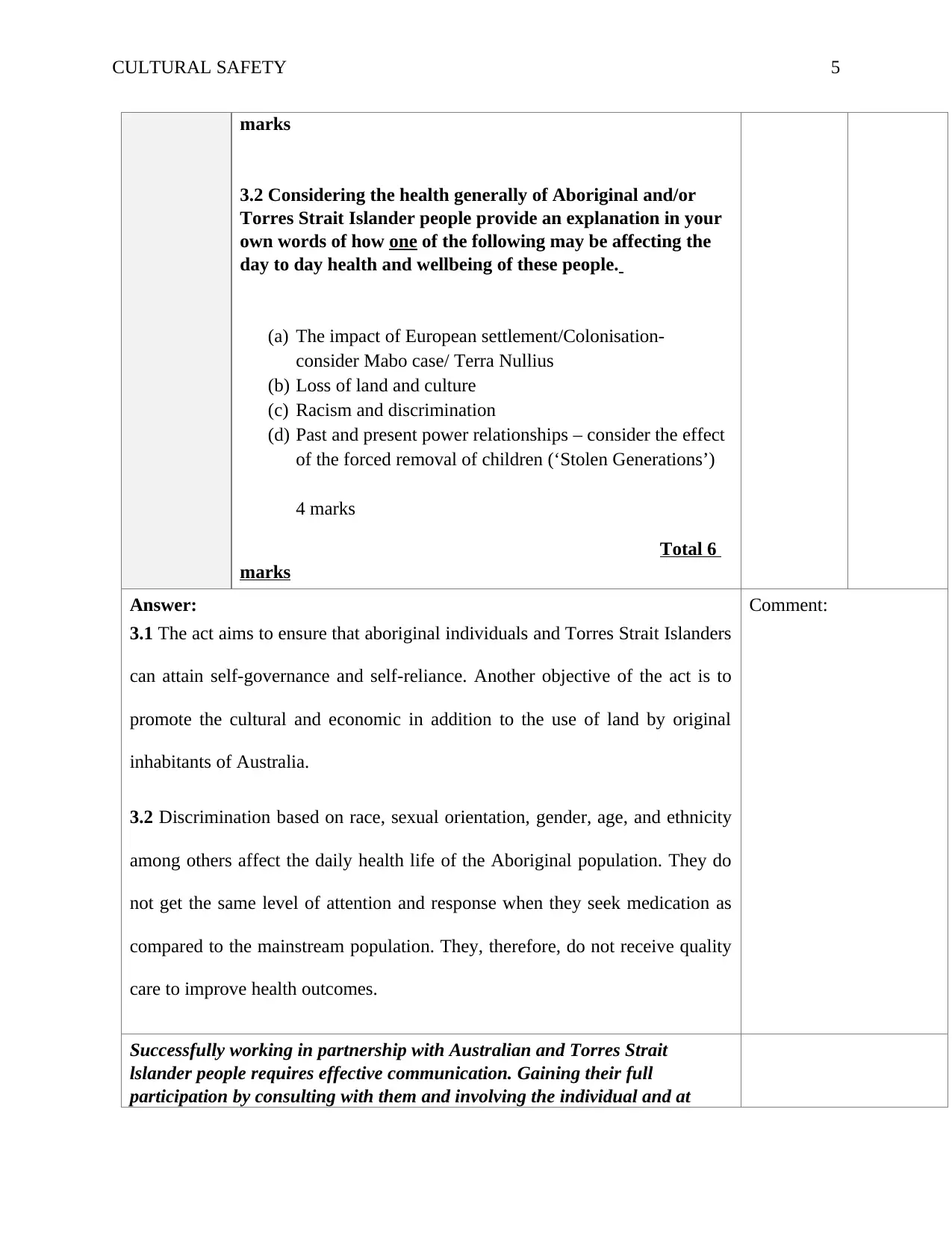
CULTURAL SAFETY 5
marks
3.2 Considering the health generally of Aboriginal and/or
Torres Strait Islander people provide an explanation in your
own words of how one of the following may be affecting the
day to day health and wellbeing of these people.
(a) The impact of European settlement/Colonisation-
consider Mabo case/ Terra Nullius
(b) Loss of land and culture
(c) Racism and discrimination
(d) Past and present power relationships – consider the effect
of the forced removal of children (‘Stolen Generations’)
4 marks
Total 6
marks
Answer:
3.1 The act aims to ensure that aboriginal individuals and Torres Strait Islanders
can attain self-governance and self-reliance. Another objective of the act is to
promote the cultural and economic in addition to the use of land by original
inhabitants of Australia.
3.2 Discrimination based on race, sexual orientation, gender, age, and ethnicity
among others affect the daily health life of the Aboriginal population. They do
not get the same level of attention and response when they seek medication as
compared to the mainstream population. They, therefore, do not receive quality
care to improve health outcomes.
Comment:
Successfully working in partnership with Australian and Torres Strait
lslander people requires effective communication. Gaining their full
participation by consulting with them and involving the individual and at
marks
3.2 Considering the health generally of Aboriginal and/or
Torres Strait Islander people provide an explanation in your
own words of how one of the following may be affecting the
day to day health and wellbeing of these people.
(a) The impact of European settlement/Colonisation-
consider Mabo case/ Terra Nullius
(b) Loss of land and culture
(c) Racism and discrimination
(d) Past and present power relationships – consider the effect
of the forced removal of children (‘Stolen Generations’)
4 marks
Total 6
marks
Answer:
3.1 The act aims to ensure that aboriginal individuals and Torres Strait Islanders
can attain self-governance and self-reliance. Another objective of the act is to
promote the cultural and economic in addition to the use of land by original
inhabitants of Australia.
3.2 Discrimination based on race, sexual orientation, gender, age, and ethnicity
among others affect the daily health life of the Aboriginal population. They do
not get the same level of attention and response when they seek medication as
compared to the mainstream population. They, therefore, do not receive quality
care to improve health outcomes.
Comment:
Successfully working in partnership with Australian and Torres Strait
lslander people requires effective communication. Gaining their full
participation by consulting with them and involving the individual and at
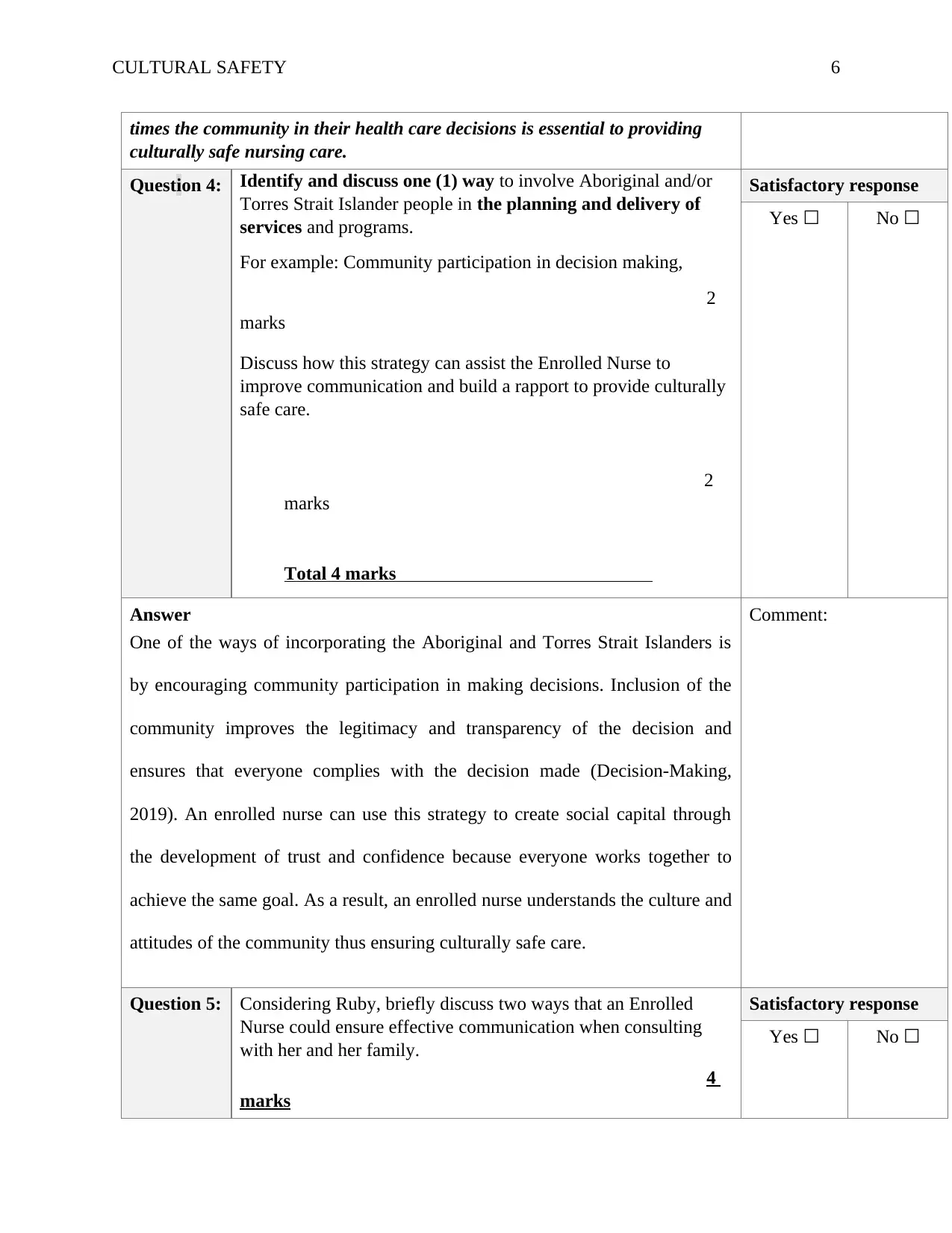
CULTURAL SAFETY 6
times the community in their health care decisions is essential to providing
culturally safe nursing care.
Question 4: Identify and discuss one (1) way to involve Aboriginal and/or
Torres Strait Islander people in the planning and delivery of
services and programs.
For example: Community participation in decision making,
2
marks
Discuss how this strategy can assist the Enrolled Nurse to
improve communication and build a rapport to provide culturally
safe care.
2
marks
Total 4 marks
Satisfactory response
Yes ☐ No ☐
Answer
One of the ways of incorporating the Aboriginal and Torres Strait Islanders is
by encouraging community participation in making decisions. Inclusion of the
community improves the legitimacy and transparency of the decision and
ensures that everyone complies with the decision made (Decision-Making,
2019). An enrolled nurse can use this strategy to create social capital through
the development of trust and confidence because everyone works together to
achieve the same goal. As a result, an enrolled nurse understands the culture and
attitudes of the community thus ensuring culturally safe care.
Comment:
Question 5: Considering Ruby, briefly discuss two ways that an Enrolled
Nurse could ensure effective communication when consulting
with her and her family.
4
marks
Satisfactory response
Yes ☐ No ☐
times the community in their health care decisions is essential to providing
culturally safe nursing care.
Question 4: Identify and discuss one (1) way to involve Aboriginal and/or
Torres Strait Islander people in the planning and delivery of
services and programs.
For example: Community participation in decision making,
2
marks
Discuss how this strategy can assist the Enrolled Nurse to
improve communication and build a rapport to provide culturally
safe care.
2
marks
Total 4 marks
Satisfactory response
Yes ☐ No ☐
Answer
One of the ways of incorporating the Aboriginal and Torres Strait Islanders is
by encouraging community participation in making decisions. Inclusion of the
community improves the legitimacy and transparency of the decision and
ensures that everyone complies with the decision made (Decision-Making,
2019). An enrolled nurse can use this strategy to create social capital through
the development of trust and confidence because everyone works together to
achieve the same goal. As a result, an enrolled nurse understands the culture and
attitudes of the community thus ensuring culturally safe care.
Comment:
Question 5: Considering Ruby, briefly discuss two ways that an Enrolled
Nurse could ensure effective communication when consulting
with her and her family.
4
marks
Satisfactory response
Yes ☐ No ☐
⊘ This is a preview!⊘
Do you want full access?
Subscribe today to unlock all pages.

Trusted by 1+ million students worldwide
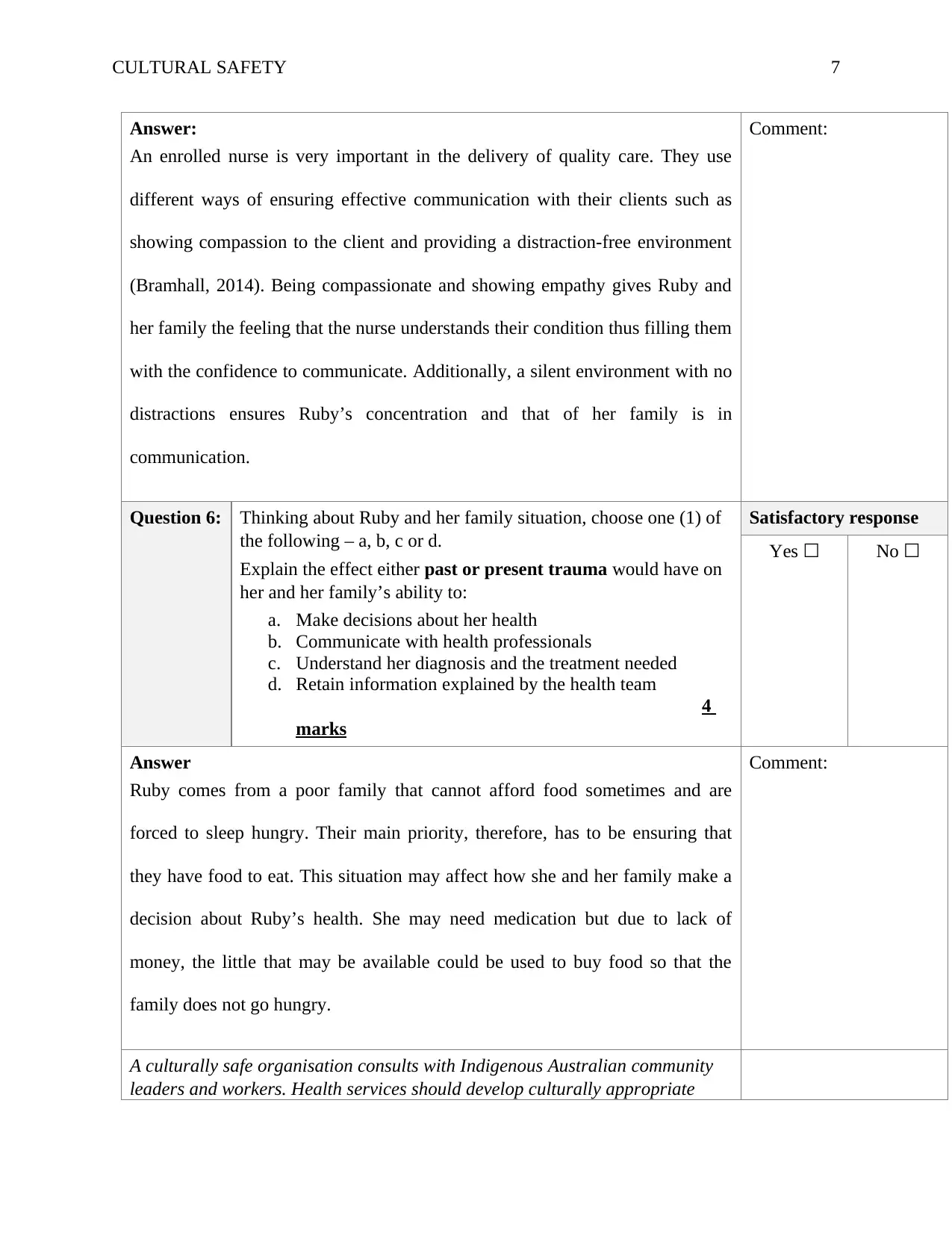
CULTURAL SAFETY 7
Answer:
An enrolled nurse is very important in the delivery of quality care. They use
different ways of ensuring effective communication with their clients such as
showing compassion to the client and providing a distraction-free environment
(Bramhall, 2014). Being compassionate and showing empathy gives Ruby and
her family the feeling that the nurse understands their condition thus filling them
with the confidence to communicate. Additionally, a silent environment with no
distractions ensures Ruby’s concentration and that of her family is in
communication.
Comment:
Question 6: Thinking about Ruby and her family situation, choose one (1) of
the following – a, b, c or d.
Explain the effect either past or present trauma would have on
her and her family’s ability to:
a. Make decisions about her health
b. Communicate with health professionals
c. Understand her diagnosis and the treatment needed
d. Retain information explained by the health team
4
marks
Satisfactory response
Yes ☐ No ☐
Answer
Ruby comes from a poor family that cannot afford food sometimes and are
forced to sleep hungry. Their main priority, therefore, has to be ensuring that
they have food to eat. This situation may affect how she and her family make a
decision about Ruby’s health. She may need medication but due to lack of
money, the little that may be available could be used to buy food so that the
family does not go hungry.
Comment:
A culturally safe organisation consults with Indigenous Australian community
leaders and workers. Health services should develop culturally appropriate
Answer:
An enrolled nurse is very important in the delivery of quality care. They use
different ways of ensuring effective communication with their clients such as
showing compassion to the client and providing a distraction-free environment
(Bramhall, 2014). Being compassionate and showing empathy gives Ruby and
her family the feeling that the nurse understands their condition thus filling them
with the confidence to communicate. Additionally, a silent environment with no
distractions ensures Ruby’s concentration and that of her family is in
communication.
Comment:
Question 6: Thinking about Ruby and her family situation, choose one (1) of
the following – a, b, c or d.
Explain the effect either past or present trauma would have on
her and her family’s ability to:
a. Make decisions about her health
b. Communicate with health professionals
c. Understand her diagnosis and the treatment needed
d. Retain information explained by the health team
4
marks
Satisfactory response
Yes ☐ No ☐
Answer
Ruby comes from a poor family that cannot afford food sometimes and are
forced to sleep hungry. Their main priority, therefore, has to be ensuring that
they have food to eat. This situation may affect how she and her family make a
decision about Ruby’s health. She may need medication but due to lack of
money, the little that may be available could be used to buy food so that the
family does not go hungry.
Comment:
A culturally safe organisation consults with Indigenous Australian community
leaders and workers. Health services should develop culturally appropriate
Paraphrase This Document
Need a fresh take? Get an instant paraphrase of this document with our AI Paraphraser
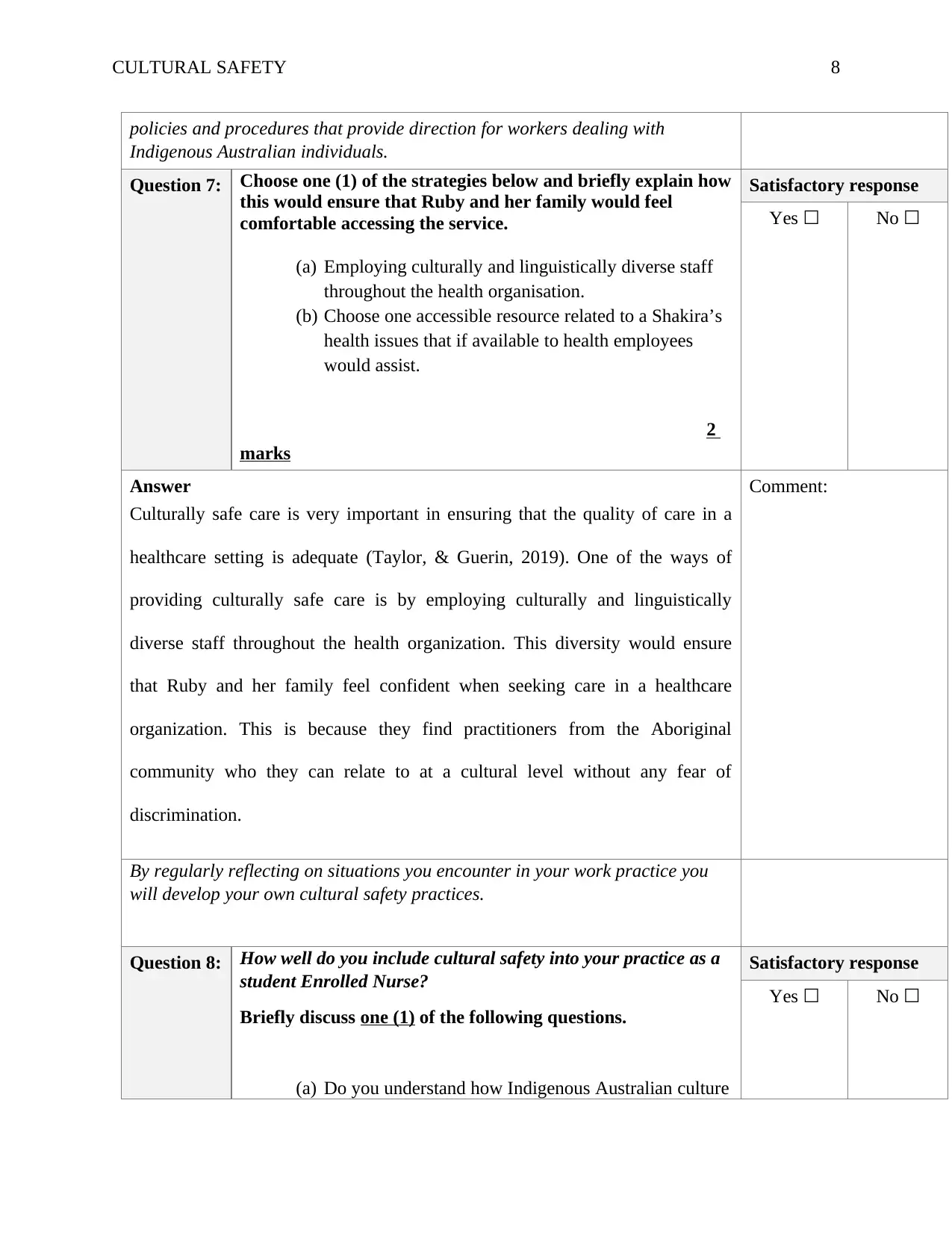
CULTURAL SAFETY 8
policies and procedures that provide direction for workers dealing with
Indigenous Australian individuals.
Question 7: Choose one (1) of the strategies below and briefly explain how
this would ensure that Ruby and her family would feel
comfortable accessing the service.
(a) Employing culturally and linguistically diverse staff
throughout the health organisation.
(b) Choose one accessible resource related to a Shakira’s
health issues that if available to health employees
would assist.
2
marks
Satisfactory response
Yes ☐ No ☐
Answer
Culturally safe care is very important in ensuring that the quality of care in a
healthcare setting is adequate (Taylor, & Guerin, 2019). One of the ways of
providing culturally safe care is by employing culturally and linguistically
diverse staff throughout the health organization. This diversity would ensure
that Ruby and her family feel confident when seeking care in a healthcare
organization. This is because they find practitioners from the Aboriginal
community who they can relate to at a cultural level without any fear of
discrimination.
Comment:
By regularly reflecting on situations you encounter in your work practice you
will develop your own cultural safety practices.
Question 8: How well do you include cultural safety into your practice as a
student Enrolled Nurse?
Briefly discuss one (1) of the following questions.
(a) Do you understand how Indigenous Australian culture
Satisfactory response
Yes ☐ No ☐
policies and procedures that provide direction for workers dealing with
Indigenous Australian individuals.
Question 7: Choose one (1) of the strategies below and briefly explain how
this would ensure that Ruby and her family would feel
comfortable accessing the service.
(a) Employing culturally and linguistically diverse staff
throughout the health organisation.
(b) Choose one accessible resource related to a Shakira’s
health issues that if available to health employees
would assist.
2
marks
Satisfactory response
Yes ☐ No ☐
Answer
Culturally safe care is very important in ensuring that the quality of care in a
healthcare setting is adequate (Taylor, & Guerin, 2019). One of the ways of
providing culturally safe care is by employing culturally and linguistically
diverse staff throughout the health organization. This diversity would ensure
that Ruby and her family feel confident when seeking care in a healthcare
organization. This is because they find practitioners from the Aboriginal
community who they can relate to at a cultural level without any fear of
discrimination.
Comment:
By regularly reflecting on situations you encounter in your work practice you
will develop your own cultural safety practices.
Question 8: How well do you include cultural safety into your practice as a
student Enrolled Nurse?
Briefly discuss one (1) of the following questions.
(a) Do you understand how Indigenous Australian culture
Satisfactory response
Yes ☐ No ☐
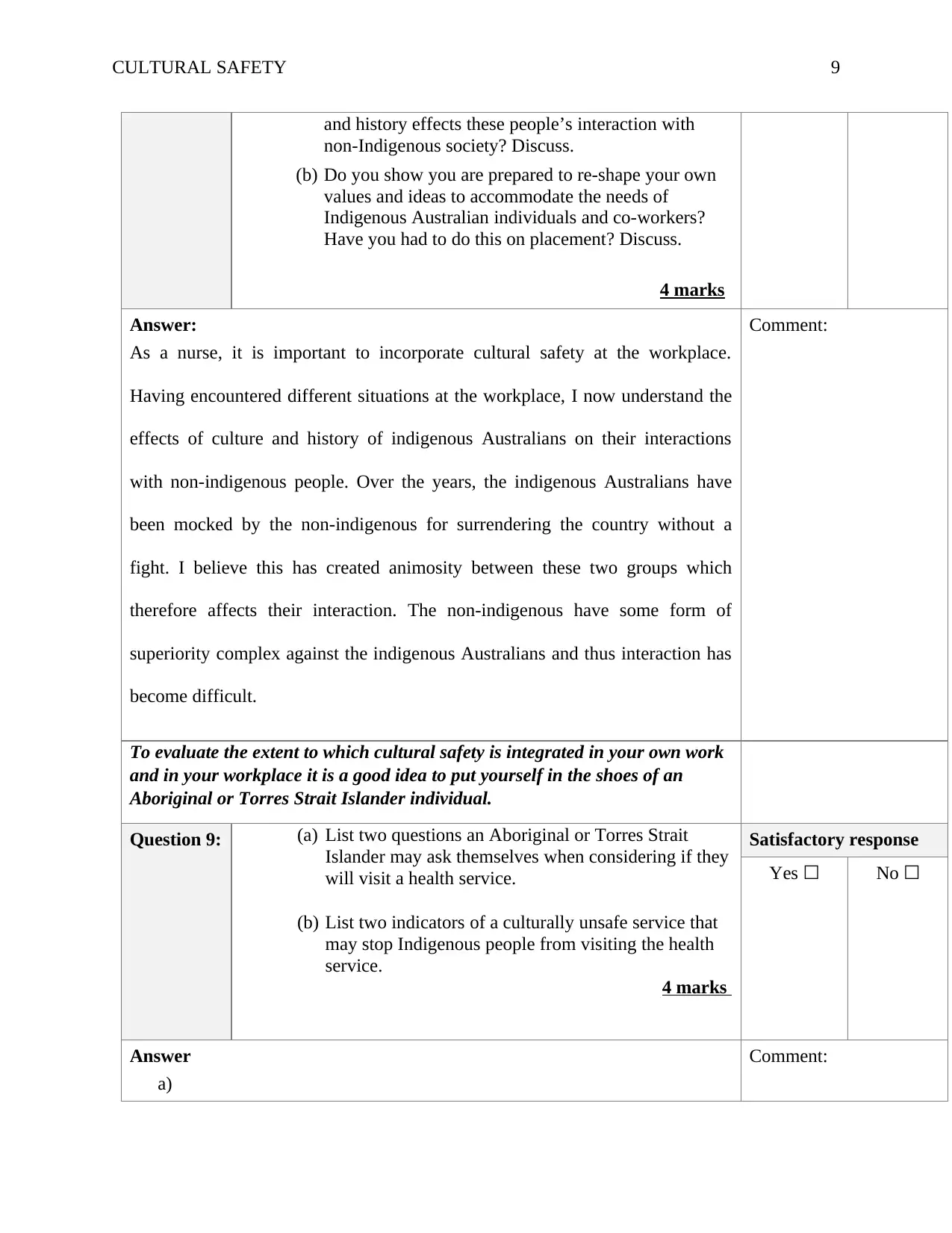
CULTURAL SAFETY 9
and history effects these people’s interaction with
non-Indigenous society? Discuss.
(b) Do you show you are prepared to re-shape your own
values and ideas to accommodate the needs of
Indigenous Australian individuals and co-workers?
Have you had to do this on placement? Discuss.
4 marks
Answer:
As a nurse, it is important to incorporate cultural safety at the workplace.
Having encountered different situations at the workplace, I now understand the
effects of culture and history of indigenous Australians on their interactions
with non-indigenous people. Over the years, the indigenous Australians have
been mocked by the non-indigenous for surrendering the country without a
fight. I believe this has created animosity between these two groups which
therefore affects their interaction. The non-indigenous have some form of
superiority complex against the indigenous Australians and thus interaction has
become difficult.
Comment:
To evaluate the extent to which cultural safety is integrated in your own work
and in your workplace it is a good idea to put yourself in the shoes of an
Aboriginal or Torres Strait Islander individual.
Question 9: (a) List two questions an Aboriginal or Torres Strait
Islander may ask themselves when considering if they
will visit a health service.
(b) List two indicators of a culturally unsafe service that
may stop Indigenous people from visiting the health
service.
4 marks
Satisfactory response
Yes ☐ No ☐
Answer
a)
Comment:
and history effects these people’s interaction with
non-Indigenous society? Discuss.
(b) Do you show you are prepared to re-shape your own
values and ideas to accommodate the needs of
Indigenous Australian individuals and co-workers?
Have you had to do this on placement? Discuss.
4 marks
Answer:
As a nurse, it is important to incorporate cultural safety at the workplace.
Having encountered different situations at the workplace, I now understand the
effects of culture and history of indigenous Australians on their interactions
with non-indigenous people. Over the years, the indigenous Australians have
been mocked by the non-indigenous for surrendering the country without a
fight. I believe this has created animosity between these two groups which
therefore affects their interaction. The non-indigenous have some form of
superiority complex against the indigenous Australians and thus interaction has
become difficult.
Comment:
To evaluate the extent to which cultural safety is integrated in your own work
and in your workplace it is a good idea to put yourself in the shoes of an
Aboriginal or Torres Strait Islander individual.
Question 9: (a) List two questions an Aboriginal or Torres Strait
Islander may ask themselves when considering if they
will visit a health service.
(b) List two indicators of a culturally unsafe service that
may stop Indigenous people from visiting the health
service.
4 marks
Satisfactory response
Yes ☐ No ☐
Answer
a)
Comment:
⊘ This is a preview!⊘
Do you want full access?
Subscribe today to unlock all pages.

Trusted by 1+ million students worldwide
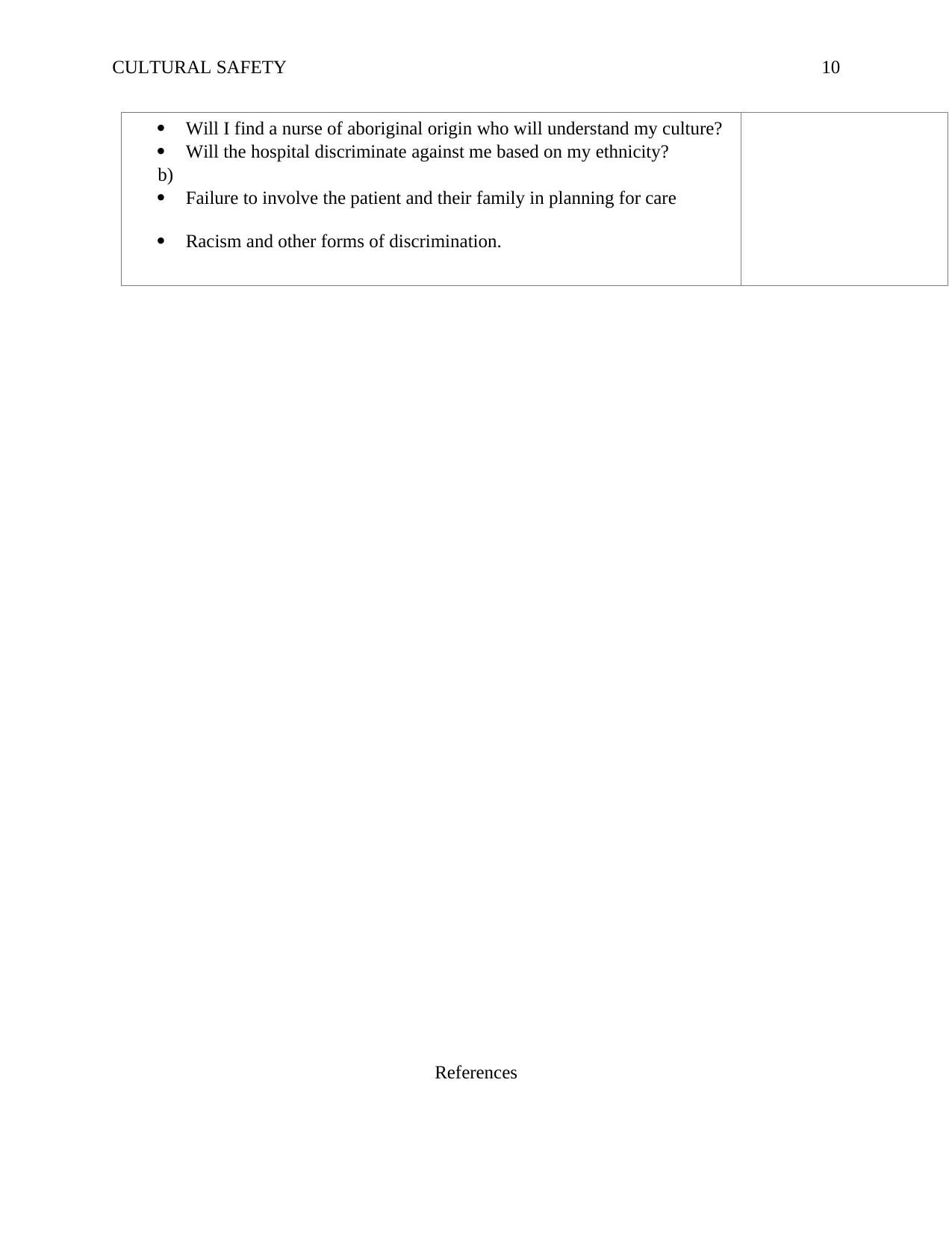
CULTURAL SAFETY 10
Will I find a nurse of aboriginal origin who will understand my culture?
Will the hospital discriminate against me based on my ethnicity?
b)
Failure to involve the patient and their family in planning for care
Racism and other forms of discrimination.
References
Will I find a nurse of aboriginal origin who will understand my culture?
Will the hospital discriminate against me based on my ethnicity?
b)
Failure to involve the patient and their family in planning for care
Racism and other forms of discrimination.
References
Paraphrase This Document
Need a fresh take? Get an instant paraphrase of this document with our AI Paraphraser
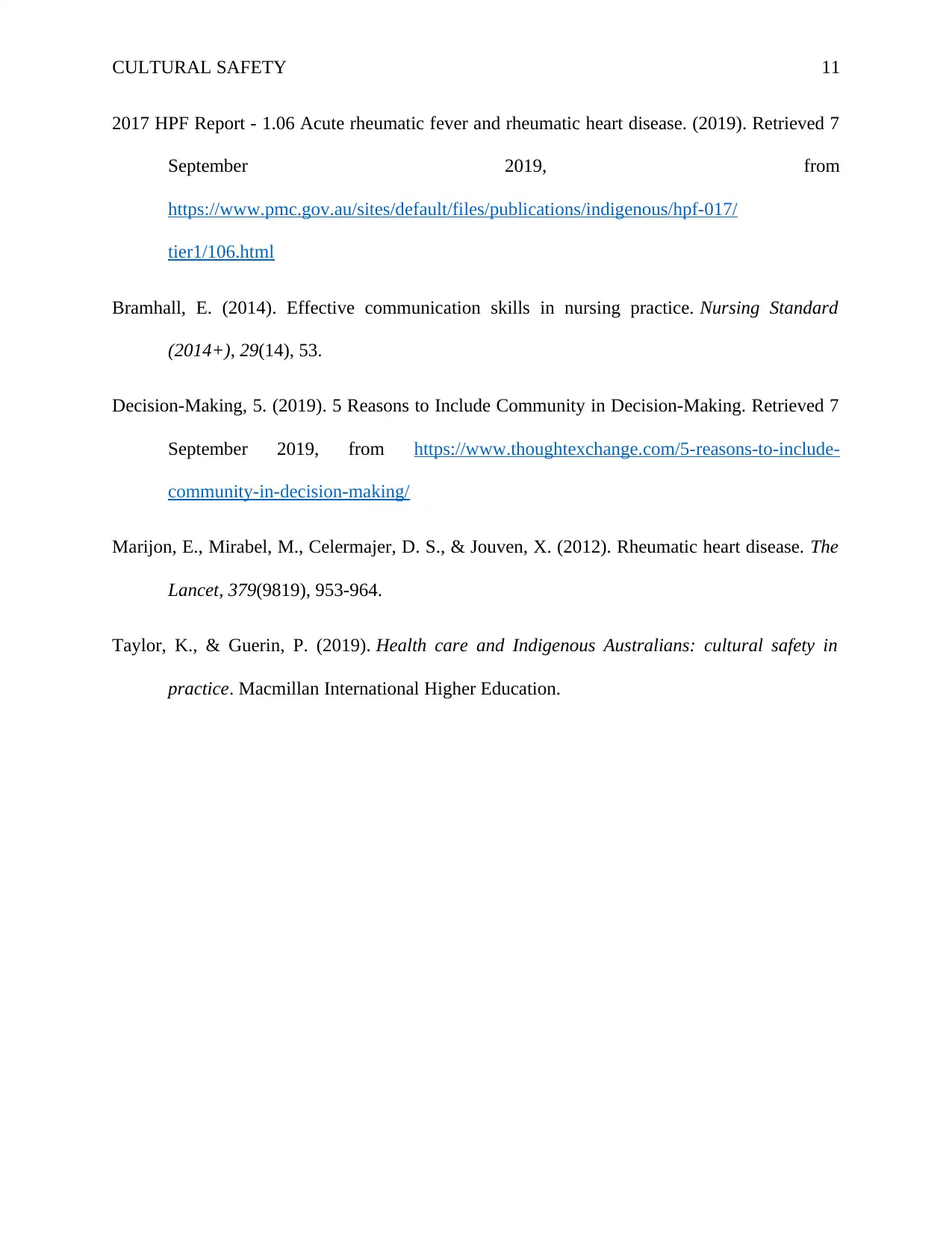
CULTURAL SAFETY 11
2017 HPF Report - 1.06 Acute rheumatic fever and rheumatic heart disease. (2019). Retrieved 7
September 2019, from
https://www.pmc.gov.au/sites/default/files/publications/indigenous/hpf-017/
tier1/106.html
Bramhall, E. (2014). Effective communication skills in nursing practice. Nursing Standard
(2014+), 29(14), 53.
Decision-Making, 5. (2019). 5 Reasons to Include Community in Decision-Making. Retrieved 7
September 2019, from https://www.thoughtexchange.com/5-reasons-to-include-
community-in-decision-making/
Marijon, E., Mirabel, M., Celermajer, D. S., & Jouven, X. (2012). Rheumatic heart disease. The
Lancet, 379(9819), 953-964.
Taylor, K., & Guerin, P. (2019). Health care and Indigenous Australians: cultural safety in
practice. Macmillan International Higher Education.
2017 HPF Report - 1.06 Acute rheumatic fever and rheumatic heart disease. (2019). Retrieved 7
September 2019, from
https://www.pmc.gov.au/sites/default/files/publications/indigenous/hpf-017/
tier1/106.html
Bramhall, E. (2014). Effective communication skills in nursing practice. Nursing Standard
(2014+), 29(14), 53.
Decision-Making, 5. (2019). 5 Reasons to Include Community in Decision-Making. Retrieved 7
September 2019, from https://www.thoughtexchange.com/5-reasons-to-include-
community-in-decision-making/
Marijon, E., Mirabel, M., Celermajer, D. S., & Jouven, X. (2012). Rheumatic heart disease. The
Lancet, 379(9819), 953-964.
Taylor, K., & Guerin, P. (2019). Health care and Indigenous Australians: cultural safety in
practice. Macmillan International Higher Education.
1 out of 11
Related Documents
Your All-in-One AI-Powered Toolkit for Academic Success.
+13062052269
info@desklib.com
Available 24*7 on WhatsApp / Email
![[object Object]](/_next/static/media/star-bottom.7253800d.svg)
Unlock your academic potential
Copyright © 2020–2025 A2Z Services. All Rights Reserved. Developed and managed by ZUCOL.





